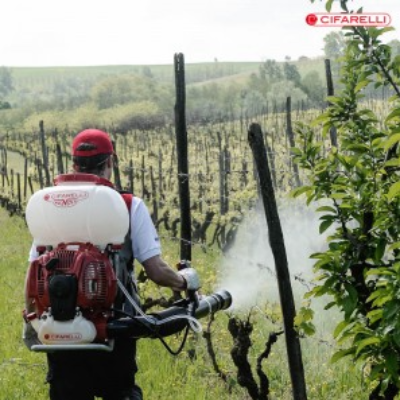31/05/2013
Treatment in the vineyard. Where the tractors do not arrive

The Italian peninsula, long and narrow, is characterized by a strong variability of pedoclimatic situations that, inevitably, affect the seasonal trend of crops and with it, adversities. To this must be added the variables introduced by the choice of variety, the sixth planting and the type of agronomic management.
So many factors of heterogeneity to consider in the management of the vineyard, that after the winter cold necessary for the plant to properly complete the annual cycle, abandons the state of quiescence to face a progressive rehydration of tissues, followed by the development of the crown and fruits.
A long and narrow territory
A period of intense rains like the one we are witnessing, in addition to having effects of leaching of nutrients and surface runoff with more or less intense erosion phenomena, has an important action on the phytopathological picture of the crop.
In particular in northern Italy, the abundant rainfall of April and the climate instability that seems to persist, are leaving room for the appearance of the first patches of oidium.
For the powdery mildew, in fact, whose wintering cycle can take place both as a mycelium latent in the buds and as a kleistotecium on the rhytimam, in spring a rain (2.5 mm) accompanied by temperatures of at least 10 degrees, to release ascospores on basal leaves. After the incubation period, the typical white patina becomes visible on the lower page of the leaf. Primary infections typically occur in late May with little noticeable signs but, it is precisely from these, that secondary body infections can take place.
In some areas, moreover, the time is ripe to intervene in the rows with the second seasonal antiperonosporic treatment, with the weeding of the subrow and with the treatment of tare and appliances in which the presence of nettle and convolvulus is detected, guests of the buzzer, vector of the black wood.
With regard to antiperonosporic treatments, it is good to take preventive action avoiding fungal infestation; it should be considered that depending on the temperature and humidity conditions, the incubation period in spring, lasts 8-10 days after the rains and, in summer, 5-6 days. A useful aid in terms of the time periods and the number of treatments to be implemented, are the forecast models made available by the regional phytosanitary services.
Small plots and difficult plots
For these, but also for other operations not mentioned, if it is impossible to intervene with mechanical means carried or towed by tractor, the choice can be directed towards the use of a shoulder atomizer.
It is the case of areas affected by steep slopes and terraces such as the Valtellina, part of Liguria, the Aosta Valley but also the area of Etna and some Tyrrhenian islands where the possibility of mechanization is scarce and most often uneconomic. Nevertheless, the solution is interesting in plots where the size and purpose of the crop do not justify investment in excessively expensive agricultural equipment.
Moreover, among the most economically expensive operations and that it would be good to mechanize also by virtue of the impact on the quality of the grapes, we can include winter pruning and harvesting. As for the phytosanitary treatments of our interest, which given the trend of rainfall could be oriented towards the use of translaminar or systemic products, the shoulder atomizer becomes a valuable ally.
The advantages that today the technology of these machines has managed to generate are countless. Starting from the attention to the environment and the operator, the latest generation machines are equipped with new diffusion systems for which it is possible to identify and adjust the position most suitable for the specific conditions of use. This reduces product waste and consequently the phenomenon of drift, the impact of which in the early stages of vegetative development is particularly critical.
Among the factors to be considered to reduce the extent of the losses of the plant mixture, the environmental conditions then the wind speed the temperature, the relative humidity and the volume of vegetation development.
Equal importance have the parameters of setting the shoulder atomizer that must take into account the mechanism of action of the product to be distributed and for which it is always good, in case of doubt, ask the dealer for advice.
They are, in fact, parameters whose impact is crucial for the success of the treatment and to reduce the percentage of product dispersed off target that would otherwise generate environmental damage but also economic.
Generally speaking, finer drops are more suitable for contact-acting products but, on the other hand, excessive pressure and a too small orifice diameter setting causes easier evaporation of the product.
The technology, updated thanks to continuous investment in research, has managed to achieve the objective of effective and targeted action on the target, by adjusting the diameter of droplets and their density, so as to obtain a greater and maximum retention and coverage by vegetation.
Finally, the advantage of using a shoulder atomizer is also reflected in the volumes, for obvious reasons, not high in the tank: an excessive dilution of the product increases the risk of runoff with greater losses on the ground.

_300x300.png)

_300x300.png)